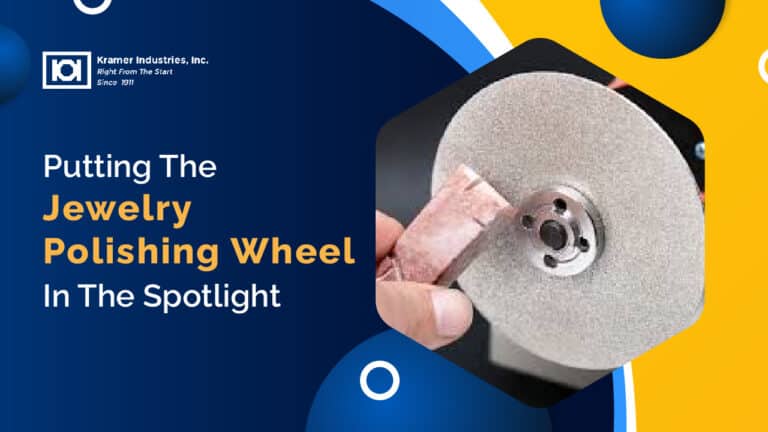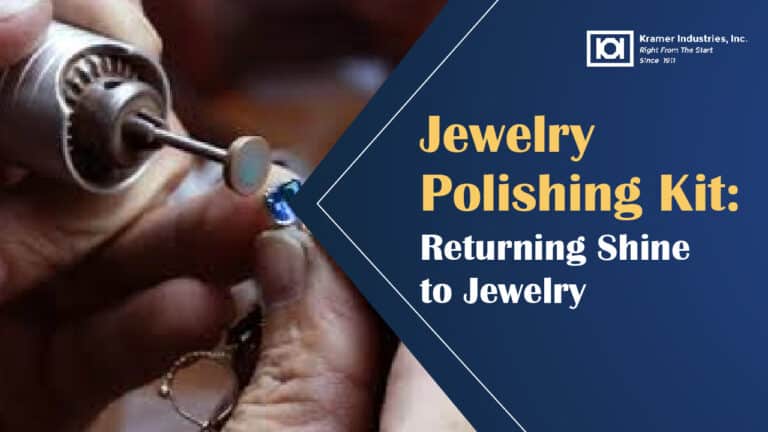Finding the Right Jewelry Polishing Compound
Selecting the right jewelry polishing compound depends on a few factors:
Material Type:
- Gold, Silver, Platinum: Rouge compounds (red or green) work best for precious metals. It gives them a high-gloss finish without scratching the surface.
- Stainless Steel, Chrome, Hard Metals: Green or blue rouge, or aluminum oxide compounds are ideal for harder metals that require more cutting power.
- Brass, Copper, Aluminum: Tripoli is perfect for softer metals. This is because it helps remove imperfections before polishing with rouge.
- Gemstones: Special care is needed. Zam works well for polishing softer stones like turquoise and is gentle enough not to scratch.
Desired Finish:
- High Gloss: Jeweler’s rouge or blue rouge provides a mirror-like shine.
- Matte or Satin Finish: Satin or matte buffs and compounds are used for a less reflective, brushed look. They are often preferred for certain jewelry styles.
- Cutting and Smoothing: More abrasive compounds like Tripoli or emery are used at the initial stages. They remove scratches and prepare the surface for finer polishing.
Type of Jewelry:
- For intricate designs or small areas, choose a compound that works well with smaller buffing wheels or brushes (e.g., white diamond or Tripoli for detailed work).
- If the jewelry has both metal and gemstones within it, choose a compound like Zam. Zam is safe for both materials.
Types of Jewelry Polishing Compounds

Jewelry polishing compounds are utilized for a particular phase during the polishing procedure. Below is an overview of the most popular ones and their purposes:1
- Rouge (Jeweler’s Rouge)/Red
Rouge is an excellent substance utilized to provide jewelry with a shiny, reflective surface. It is mild sufficient for usage after finishing the polishing procedure. It can polish the metal surface without causing any scratches.
- Tripoli/ Brown
Tripoli is a harsher compound in contrast to rouge. It is employed for getting rid of scratches, pits, or any flaws prior to the final polishing. It is an initial step that makes the surface smooth in preparation for a more refined touch.
- White Diamond/White
This substance has a moderate level of abrasiveness. It is utilized to eliminate scratches and give hard metals a semi-gloss finish before transitioning to a more refined polishing phase. It is very adaptable and can be utilized on different types of metals.
- Zam/ Green
Zam is created for softer metals and stones to provide a gentle shine without being overly harsh. It is ideal for jewelry items with metal and stone parts as it does not harm the stones.
- Fabulustre/Cream or White
Fabulustre is designed for high-luster polishing without removing much material. It produces a glossy finish, ideal for delicate jewelry that requires a final polish.
- Emery Compound/Gray or Black
Emery is a lot harsher. It is usually used in the initial stage for totally smoothing down rough surfaces and removing deep scratches or blemishes and is rather a cutting compound followed by finer polishes.
- Black Emery/Black
It is the strongest abrasive for heavy-duty applications and metals that are tough. Normally used for the first few steps to grind and cut your metal to prepare.
- Green Rouge/Green
Green rouge is used for giving a mirror-like finish to harder metals, especially stainless steel, after most of the cutting has been done with coarser compounds. It provides a fine luster and minimal abrasiveness.
- Blue Platinum Compound/Blue
In that respect, this specially formulated jewelry polishing compound for platinum gives a bright shiny finish without scratching the surface. Less abrasive, it’s used in precision polishing.
- Yellow Rouge/Yellow
This compound is specifically used for giving gold jewelry a bright, shiny finish without being too aggressive.
- Blue Rouge/ Blue
Blue rouge is ideal for giving harder metals a final polish, producing a reflective and smooth surface.
| Compound Type | Material Used For | Purpose |
| Jeweler’s Rouge | Gold, Silver, Platinum | High-gloss, mirror-like finish |
| Tripoli | Brass, Copper, Aluminum | Pre-polishing, smoothing imperfections |
| White Diamond | Hard Metals (Stainless Steel) | Scratch removal, semi-gloss finish |
| Zam | Soft Metals and Stones | Gentle polishing for both stones and metal |
| Fabulustre | Gold, Silver | High-luster, delicate polishing |
| Emery Compound | Hard Metals (Steel, Iron) | Heavy-duty cutting and smoothing |
| Green Rouge | Stainless Steel, Chrome | Fine luster, mirror finish for harder metals |
| Blue Rouge | Stainless Steel, Hard Metals | Final polish for a reflective surface |
| Yellow Rouge | Gold | Bright, shiny finish without aggression |
Each of these jewelry polishing compounds plays a critical role in the multi-step polishing process. They move from heavy cutting and smoothing to fine polishing and final shine. Depending on the metal and the finish desired, the right compound makes all the difference in turning jewelry into gleaming ornaments.
For top-tier jewelry polishing compounds, look no further than Kramer Industries. Their selection includes everything you need to achieve that perfect shine on any metal. Elevate your jewelry game with the finest compounds designed for precision and brilliance.
Frequently Asked Questions (FAQS)
- What is a jewelry polishing compound?
A jewelry polishing compound is a fine abrasive substance used to smooth, refine, and shine metal surfaces. It removes scratches, oxidation, and imperfections to give jewelry a high-gloss or satin finish, depending on the desired look. - How do I choose the right jewelry polishing compound for my jewelry?
Choose based on the metal type and desired finish.
- For gold, silver, and platinum, use rouge compounds for a mirror-like finish.
- For hard metals like stainless steel or chrome, green or blue rouge works best.
- For soft metals like brass, copper, or aluminum, start with Tripoli and finish with rouge.
- For mixed metal and gemstone jewelry, Zam is a safe, all-purpose option.
- What are the different types of jewelry polishing compounds?
Common types include Rouge, Tripoli, White Diamond, Zam, Fabulustre, Emery, Green Rouge, Blue Rouge, and Yellow Rouge. Each has unique abrasiveness and purpose—from heavy cutting and smoothing to fine finishing and high luster. - What is jeweler’s rouge used for?
Jeweler’s rouge (red rouge) is a fine polishing compound used for final polishing of precious metals like gold, silver, and platinum. It provides a high-gloss, mirror-like finish without scratching the surface. - What is the difference between Tripoli and rouge compounds?
Tripoli is a coarse compound used first to remove scratches and imperfections from softer metals. Rouge is a fine compound used afterward to bring out the final high polish and shine. - Can jewelry polishing compounds be used on gemstones?
Yes, but only certain compounds like Zam are safe for gemstones. Zam is gentle enough to polish both metal and softer stones like turquoise without causing damage or scratches. - What compound should I use for platinum jewelry?
For platinum, use blue platinum compound or green rouge. Both provide a bright, reflective finish without over-cutting or scratching the metal. - How do I get a matte or satin finish instead of a glossy one?
To achieve a matte or brushed finish, use satin or matte buffs along with less abrasive compounds. These reduce reflectivity and create a more textured, designer look on the jewelry surface. - Can I use the same polishing compound for all types of jewelry?
No. Each metal type requires a specific compound to achieve optimal results. Using the wrong compound may cause over-polishing or surface damage. It’s best to select compounds based on material hardness and finish goals. - Why choose Kramer Industries’ jewelry polishing compounds?
Kramer Industries offers a full range of professional-grade jewelry polishing compounds designed for precision, consistency, and superior shine. From Tripoli for cutting to rouge for final polishing, Kramer products deliver top-tier results for every type of jewelry and metal.



